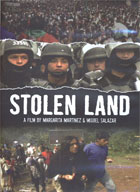
Stolen Land (Robatierra) 2010
Distributed by Icarus Films, 32 Court St., 21st Floor, Brooklyn, NY 11201; 800-876-1710
Produced by Margarita Martínez and Miguel Salazar
Directed by Margarita Martínez and Miguel Salazar
DVD, color, 73 min., Spanish with English subtitles
Sr. High - Adult
Latin American Studies, Native American Studies, Political Science
Date Entered: 02/11/2011
Reviewed by Wendy Highby, University of Northern ColoradoStolen Land concerns the efforts of the Nasa indigenous community to assert their claim upon ancestral lands. As is evident from its title, the film is sympathetic to the indigenous point of view. The Nasa people (also known as Páez Indians) reside in the state of Cauca in southwestern Colombia. They seek to reclaim the land to grow food crops. This reclamation movement conflicts with private property interests and the government’s push to grow sugarcane for biodiesel production. The government frames the reclamation attempts as “invasions”—the natives see them as “recoveries.”
Central to the story is the Colombian government’s noncompliance with the Nilo agreement. In a property dispute, twenty Nasa people were killed by police at Hacienda El Nilo on December 16, 1991. In the aftermath of the massacre, the government agreed to cede land to the Nasa. The film documents attempts by the Nasa Indigenous Movement to gain government compliance with the agreement some 15 to 17 years later. The filmmakers record acts of non-violent resistance from 2006 to 2008 (plantation occupations, highway blockades, meetings, and marches). The Movement has an organized Indigenous Guard. Some content is focused upon Lucho Acosta, a leader of the Indigenous Guard. The film shows the Indigenous Guard as they are trained in passive resistance techniques. Each Nasa Guard member is armed only with a symbolic staff. Employing the tactics of non-violence, the Nasa occupy La Emperatriz plantation but are subsequently evicted. They participate in a Panamerican Highway blockade. The documentarians provide national political context with clips of Senate debates, news conference footage, media coverage, and responses of President Alvaro Uribe and Agricultural Minister Andres Felipe Arias.
Internal conflict arises when a dissident movement surfaces within the Nasa community, called the “Grandchildren of Manuel Quintin Lame.” The “Grandchildren” are orphans of the Nilo massacre and they grow impatient with the Indigenous Guard and the slow pace of change. Group dynamics are displayed in discussions about the dissident movement at community meetings. Finally, marches to Cali and Bogota in 2008 culminate in a Nasa meeting with President Uribe that fails to be conciliatory.
Stolen Land strikingly conveys the integrity and perseverance of the Nasa people. In the words of leader Lucho Acosta, “our struggle will continue until the sun burns out.” Viewers of this film will learn about reparations, civil disobedience, conflict resolution, land claims, land tenure, and Native American social movements. It could support a broad range of curriculum in the social sciences.
Awards
- Best Documentary, South Habana Film Festival